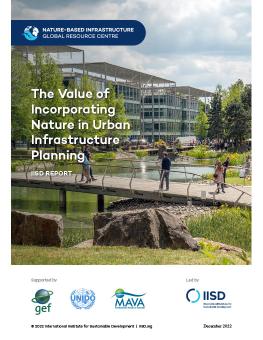
The Value of Incorporating Nature in Urban Infrastructure Planning
Cities around the world are struggling to provide people with the infrastructure they need to thrive. Nature-based infrastructure (NBI) delivers cost-effective, climate-resilient infrastructure services and generates a wealth of co-benefits for citizens, such as reduced air pollution and improved well-being. It also creates an enabling environment for other sustainable infrastructure. To maximize the benefits of NBI, the value of nature must be at the heart of urban infrastructure planning.
This report explores how nature-based infrastructure (NBI) responds to pressing urban challenges and supports the creation of sustainable cities. It starts by illustrating what makes cities sustainable and the potential role of NBI. Next, it summarizes research findings about the value of four NBI types for sustainable urban infrastructure: urban green spaces, green roofs, stormwater infrastructure, and wetlands and lakes. The literature review is complemented by selected NBI case studies that have been assessed with the Sustainable Asset Valuation (SAVi) methodology. Finally, the report concludes by arguing that sustainable cities require strategic, cross-sectoral urban infrastructure planning with nature at its core.
Key messages:
- Urban development—if done unsustainably—is one of the main drivers of biodiversity loss. Population growth in cities makes infrastructure needs in urban areas particularly high and places enormous pressure on the environment. Climate change further exacerbates this impact.
- Building with—rather than against—nature has direct benefits for cities. Nature-based infrastructure (NBI) provides cost-effective and climate-resilient infrastructure solutions and generates a wealth of co-benefits for citizens, such as reduced air pollution and improved well-being.
- NBI in cities is, on average, 42% cheaper and creates 36% more value than relying only on grey infrastructure if avoided costs and co-benefits are taken into account. Case studies by the NBI Global Resource Centre show that for each dollar invested, NBI in cities can generate up to 30 times that amount in returns for society, making investments in urban nature economically viable.
- Building with nature also supports investments in other sustainable infrastructure, such as mobility, water, and energy, by increasing their resilience and effectiveness. Additional research is required to better understand and quantify these benefits and fully leverage nature’s contribution to sustainable cities.
- To make the most of the benefits of NBI, the value of nature must be at the heart of strategic, cross-sectoral urban planning. Planners, policy-makers, and budget holders need to use a systemic perspective to understand how to best maximize the benefits of NBI for sustainable cities.
Participating experts
You might also be interested in
How Can We Work With Nature to Tackle Drought and Desertification?
Drought is one of the most devastating and pervasive challenges exacerbated by climate change. However, we can work to reduce its effects through nature-based solutions for land restoration and climate-smart agriculture.
Estimate of Natural Infrastructure Public Grant Funding in Canada and in the Canadian Prairies
This analysis estimated the amount of public grant funding available across Canada and in the Canadian Prairie provinces for investing in urgently needed natural infrastructure.
Sustainable Asset Valuation of Ecosystem-Based Adaptation Measures in the Reventazón River Basin, Costa Rica
In this integrated cost-benefit analysis, the Nature-Based Infrastructure (NBI) Global Resource Centre demonstrates the potential of ecosystem-based adaptation to stabilize hydrology and ensure a reliable water and energy supply in the Reventazón region of Costa Rica.
Sustainable Asset Valuation of Reforestation in Uganda
In this integrated cost-benefit analysis, the Nature-Based Infrastructure Global Resource Centre demonstrates the potential of nature-based infrastructure (NBI) to improve climate-related flooding and landslides in Kasese, Uganda, through the Bring Back Our Trees reforestation project.